by Lauren Chase Rowell
” That land is a community is the basic concept of ecology, but that land is to be loved and respected is an extension of ethics.” -Aldo Leopold
Part 2
Conscious Design in the Yard and Landscape
Dalton’s Pasture is a historical name our family has chosen to call our nineteen-acre, permaculture “farmstead” in honor of the folks who first planted their roots in the soils and harvested its timbers to build the farmhouse. We say they did the “really hard work” by building the post and beam structure, clearing the land with an axe and team of horses, and surrounding the fields and pasture with over a mile of stone walls. Here they eked out an existence, raised a family, and died as the cemetery on the northeastern corner of the property affirms.
The Daltons stewarded the land from early 1800 to around 1875. They grew their food, put up enough hay to over-winter a cow for dairy products and a horse for transportation, and cut cords of firewood to warm the thin-walled rooms of the house they hewed from logs on the land. They made enough brick on site for their chimneys, and met most of their subsistence from the economy of the land.
The History of a Property
Tenants who followed the Daltons did not live rooted in the same way. Going over the deeds, we can safely assume that only six different parties owned the property, though there had been some renters over the years. The history of land ownership is important in terms of understanding how the land was used, abused, rested, and restored over time. The house and land exchanged hands as an investment by a local family in town, and then it was occupied by a series of unrooted residents: out-of state people using the country house to escape the city heat, a vet from Ohio, random renters and live-ins who traded cheap rent for a house on a barely passable road, with no plumbing, and a total of four electrical outlet boxes and switches. When people plan to stay in a place temporarily, little time or money is invested in maintenance.
In permaculture we say, “The problem is the solution,” which beckons us to look for the synergistic good, and opportunity, in all scenarios. Twenty-five years ago, the house was in such a state of disrepair that it caused the price to be affordable for my young family. We had the skills to shine it up and place it back on its feet, which was a good fit.
The land, however, after a century of slowly declining fertility and overuse by the Dalton’s, had sat pretty much unused until we came. The land had rested, grown in with succession, and begun the long, slow process of building complexity within its soils, waterways, and life. The unrooted dwellers of the fifty years prior to our arrival stayed in the house, except for evidence of a few animal pens, firewood pilfering, and some poorly done logging. However, these latest acts of resource retrieval wreaked less damage than that sustained over one hundred years of loss of fertility during the Dalton’s tenure. Continuous overgrazing of the croplands resulted in thin, eroded soil. Without the addition of humus to the earth it lacked structure and tilth which affected the presence of life and moisture in the soils.
Enter our family. We were strong on building skills, and though we were weak on reading the land, we were patient and observant. I would like to believe that hearts open to reschooling and unlearning countered our instances of arrogance and ignorance. Permaculture, old Yankee ingenuity, and common sense were tools within our toolbox alongside inflated dreams and burgeoning work ethic.
Restoring the Land = Restoring Ourselves
Despite the challenge of months of grueling work to renovate the house into a home, there were moments of refreshing inspiration when we would drop our hammers and tool belts and simply walk the acreage. As we experienced a level of rejuvenation in unstructured exploration of the land, we gradually became attuned to the workings of nature: gentle breezes and wind tunnels, warm pockets trapping the sun’s rays, and how the surface water moved over the uplands and lowlands. We noticed general patterns within the topography; the soils on the top of slopes were drier and harbored less plant life, whereas the lower slopes supported denser and more diverse vegetation. Our observation skills grew in tandem with the balance of time we spent getting to know our surroundings, and this relationship fed and restored us from many long workdays. In retrospect, one of the most important decisions we made early on, as a result of keen observation, was to build a small dam in a dismal, seasonal trickle of water that wound through a narrow, red maple swamp. We took an afternoon off, and after studying the channel of the rivulet, we found the logical place to block it and built a wooden structure about twenty-four inches high.
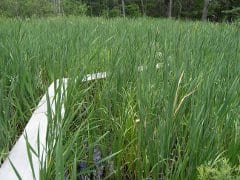
The center of the wetland we created is a sea of green cattails. The root tuber, the bottom few inches of the inner stalk, the pollen, and the young seed structure of the cattail are edible. We see the cattails as part of the food system.
We looked at the land in terms of diversity; diversity of species, habitat, and composition of the different vegetated areas. When we cut back saplings which were encroaching the yard, we were careful to select out any tree which was a “new” succession species. The word biodiversity had not yet come into vogue, but with each sensitive choice we made, there seemed to be a flourishing of life. The lesson we learned: if you want to revitalize the place you’ve chosen to put down your roots, bring in a diversity of living things and to accomplish that in the fastest possible way, make water available. To make water available, study and understand your watershed, from the big one in your region to the little ones crossing your property! Then, capture and store the water!
Water Brings in Life
For twenty-five years we have continued to add water to our landscape. Water seems to beget more water as it attracts moisture to itself. The area we created long ago has become a vibrant wetland. The dammed wetland fed the narrow, mostly dry channel that wound and disappeared over and under our land. Over time, the water we captured helped develop a series of wet habitats through forested wetland, open pasture, shrub lands, and the landscaped yard.
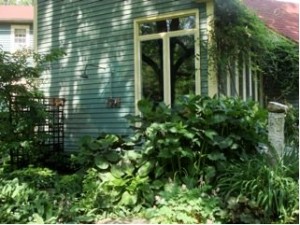
While the Kentucky wisteria on the corner of the building fixes nitrogen for the garden below and shades the sunroom, the outdoor shower provides gray water to the elderberry in front of the trellis. Dense plantings increase habitat and biodiversity.
One doesn’t have to build a wetland of the proportions we did in order to kick-start the building of life in a landscape. Any water will do. We decided that an outdoor shower would not only be convenient, but also put the much-needed water directly onto the landscape. Then we added six full-sized wooden whiskey barrels that collect rainwater and are strategically placed where we can use them handily. Rainwater, full of oxygen and nutrients from air pollution, is used to water container plants, transplants, and propagation seedlings and to fill chicken waterers. Tree frogs often take up residence on the barrels, their beautiful skin blending in with the silver wood.
Where rainwater collection isn’t enough of a solution in sheet drainage areas such as large roofs, we have constructed two “water features.” One collects an abundance of roof runoff. When it ‘overflows’, it is designed to fill up the surrounding area which was dug down to an eighteen-inch depth, fitted with a piece of recycled rubber roofing, and refilled by mixing forest leaf mold and compost into the gravelly soil taken out of the hole. A bog garden now thrives there, allowing specialist niches for biodiversity in a place that used to be a gravel-desert. It seconds as a place to scoop out water for houseplants, to water thirsty dogs, and to cool and humidify the microclimate.
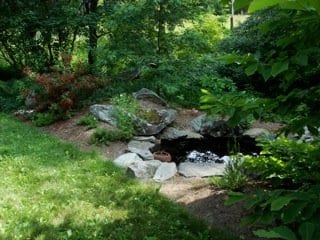
This landscape with a water garden provides stacking functions: habitat, water catchment, increased humidity and cooling, sediment settlement and filtration, soil improvement, and a sense of calm beauty.
The edge of the water feature houses an antique, copper hand pump recovered from the kitchen sink in the el of the farmhouse. A tiny solar panel no bigger than a clipboard and an old car battery capture “free” energy to run a pump and circulator that turns the old, sentimental pump into a fountain. As visitors and family approach the entrance to the mud room, they are greeted by the tinkling of water, a lush oasis of greenery with a full compliment of frogs, newts, and tiny quarter-sized turtles, and a cool, refreshing welcome. The fountain, in case you’re thinking “too cutesy” for a permaculture existence, stacks functions by aerating the water and attracting wildlife with its wet splashing noise.
The other water feature is on the lowest part of a gradual slope. The slope was graded to move water away from the antique buildings while spreading the flow over a wide area. Water is then intercepted into a densely planted polyculture. Any excess run-off not infiltrated on its journey across the landscape, ends up in the water feature. Here, any sediments and organic nutrients have a chance to settle out, where they become the substrate and food resource for the native pond lilies, cardinal flowers, and floating duck weed.
Again, through stacking functions, this consciously designed system serves many purposes. It provides a habitat with shallow sloping sides to accommodate different animals than the hand pump water feature. It serves as a sediment catchment for water that will eventually end up in the wetland system we created twenty-five years ago. It is a perceptual border between the human-made landscape and the native woodland we are turning into a forest garden. And it waters thirsty insects, wildlife, and our dogs.
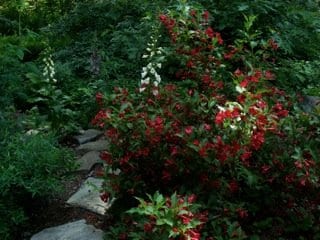
A plant guild serves to improve the environment around a newly installed water catchment pond. A pin oak will grow to the canopy tree and provide acorns, a weigela feeds and attracts hummingbirds, and several useful herbs, such as fox glove, fill the understory. Dense vegetation and stepping stones protect the soil and prevent compaction.
The soil in the area near the second water feature is poor and sandy. Use of nitrogen fixers and dynamic accumulator plants will build soil over time. Meanwhile, stepping stones keep people on the path to reduce soil compaction, and leaf litter is left on. The dense layers of structural vegetation further protect the soil from pelting rain, northwest winds, and the high-noon sun. A native pin oak transplant, a future source of acorns, occupies the upper layers of the canopy along with nitrogen fixing laburnum. A small sweep of Carolina thermopsis also fixes nitrogen. Foxglove, Joe-Pye weed, woodland aster, and white turtlehead attract insects and contribute to herbal medicine on site, if needed. A ‘Red Prince’ weigela, known for its long flowering period, attracts and feeds hummingbirds. And bearberry is establishing itself as a ground cover.
Building a Perennial Food System
At the same time we were “collecting and redirecting the energy” found in water, we were also mapping out trees to save and trees to remove. The hardest thing was to be patient and see what would grow from the inherent seed bank within the soil. Little to nothing would have grown if we had not captured and stored water in wetlands, swales, and in the soil column, as well as in water-feature-ponds and rain barrels. Seeds will not readily germinate in dry, lifeless soils. We could not irrigate new plantings due to the precarious nature of a fifteen foot, shallow well, which provided all of the family’s water, but once water was reestablished on site by the cyclical absorption and transpiration by plants and improved soils, it was time to begin thinking about plant guilds.

This food system integrates plant guilds, forest gardens, and polycultures into a highly productive ''outdoor supermarket". Maple syrup, butternuts, black walnuts, oyster mushrooms, sumac ade, and Concord grapes are products from the forest garden alone! A ginkgo grows in the foreground, and edible violets carpet the ground.
Permaculture stresses the importance of diversity more than any other interdisciplinary practice or study. It kicks ecology up a notch as it blends the complexities of human needs and human nature with natural systems. For example, humans can benefit greatly by eating fresh, nutrient rich foods from their diverse landscapes. Permaculture advocates for building plant guilds, the thoughtful design of putting useful plants together that end up being system collaborators more than competitors. Plant guilds are more deliberate than polycultures, and tend to partition resources which allow plants to live in densely knitted groups with the by-products of one plant becoming the resource of another. A well-planned plant guild can harbor a lot of diversity.
Over time, by choosing saplings from a thicket of growth between the roadway and stonewall bordering our property, we retained a diversity of species, while saving money, time, and our area’s genetic diversity. Sugar maple saplings were left along the road to provide sap for maple syrup. Although it may have looked cool to save a uniform line of same-sized maples spaced evenly along the stonewall-lined road, this was not the permaculture way. Instead, we selectively thinned while integrating other species within the mix. We kept butternut, red oak, and black cherry for diversity and as an insurance policy against losing some trees to sugar maple decline or road salt. Our forest-garden-food-system was in its infancy.
Adding Smaller Trees and Shrubs
We planted a diverse polyculture of fruit trees on the southwest side of the sap trees. Heirloom apples, Asian pears, nectarines, peaches, plums, and cherries were plotted out. Wild roses, comfrey, chives, wild strawberry, and garlic chives grow in the understory. Although red raspberries, gooseberries, blackberries, asparagus, and strawberries are kept in rows, they are an integral part of the system. Chicken tractors (portable chicken pens) can be pushed up and down the rows so the chickens can “mow” and fertilize the system. Leaves and ramail wood, derived from the sugar maples and butternuts – both dynamic accumulators – fall and get caught around the bases of the food plants. Dynamic accumulators concentrate minerals from the subsoil in their leaves and plant parts, releasing them through decomposition, in place, without any intervention on our part.
Highbush blueberry shrubs, elderberry, and amelanchier have been added on the west side of the extended orchard, along the edge of the wetland we started with twenty-five years ago. Since the early days of raising the water level, cattails have recently emerged and serve as a giant filtering system in the wetland. All plant parts of the cattail are edible, and the leaves can be woven into chair seats. We use the fluffy seed heads for a down-like nesting material for bobwhite quail.
Ground Covers Tie It All Together
In this intentional food system, it is important to note that the pasture-like-grass ground cover contains over sixty species of forbs, herbs, and clovers. While the clovers fix nitrogen, the other plants provide an abundance of fruits, nectar, pollen, and greenery for a multitude of wildlife. In the safety of an organic food system like this, we can forage freely between the fruits and berries, thus extending the food-growing season for a month earlier in the spring and a month later into the fall.
Black locust, an extremely rot-resistant wood, has been used to build two tall pergolas. The rugged structures support hardy kiwi vines, grape cultivars, hops, and another nitrogen fixer, groundnut. There are two young ginkgos from which we harvest the leaves for ‘’tea’’ and medicine. We allowed a patch of staghorn sumac to grow up on the east edge. The pheasant coop is surrounded and shaded by the sumac which produces fruit that makes a pleasant and refreshing drink, and we use its framework as a natural structure to hold up a ceiling of Concord grape vines. Lastly, there is a huge dying sugar maple that we have left for the woodpeckers to enjoy. I inoculated the wood of the maple with oyster mushroom spawn, and for four years have enjoyed flushes of fresh mushrooms.
Mimicked Natural Systems Require Fewer Inputs
The perennial food system I have described is on one of four sides of the farmhouse. The same kind of system surrounds and wraps the house on all sides. I could not possibly take care of this system if it wasn’t a truly low maintenance system.
Water and moist soils are precursors to bringing in a diversity of plants and animals. The biodiversity cycles nutrients to and from the system. Biomass from living and dead organic matter builds soils. Litter, from the system itself, protects the soils built, overtime. As a system becomes full of life, nutrients and minerals become more available, and the system needs fewer and fewer inputs from us. Soils improve and obtain the ability to hold onto water and to release it when it is needed. Healthy soils do not need irrigation unless circumstances are dire.
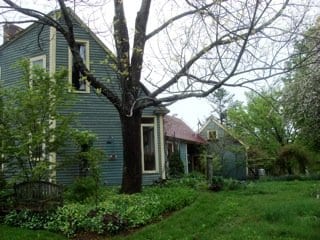
An elderberry, covered with blossoms, benefits from the extra water provided by an outdoor shower. The soils in this densely planted polyculture clean and filter the gray water.
Within diverse, healthy systems, there are inherent checks and balances. Disease and “pest” outbreaks are handled within the system. Everything is food for something else, so rarely is there “a bad bug.” If we want abundant diversity in our food systems, then we have to accept all of life’s creatures. There is a ripple effect throughout the entire system when soil is tilled, or air is polluted, or a piece of biodiversity is lost.
Most places humans inhabit lost the permanent fertility their soils once had. When we fertilize by importing amendments from “some other place”, we are borrowing the fertility from that place. We rarely know how the land and the life depending on it, was left after the minerals have been removed. This is why permaculture is so useful. Permaculture embodies practices that are holistic and mimic natural systems.
Dalton’s Pasture is slowly restoring itself. Our goal is to turn degraded pieces of land and landscape into a restored condition, and then from restoration to a regenerative capacity. It is a tall order. Permaculture is working for us. Aldo Leopold sums it up succinctly when he said, “A thing is right when it tends to preserve the integrity, stability and beauty of the biotic community. It is wrong when it tends otherwise.”
Conscious Design in the Kitchen, Part 2 of Lauren’s article, appeared in the February issue of the ELA Newsletter.
About the Author
Lauren Chase Rowell is current steward of Dalton’s Pasture in Nottingham, NH, and an organic landcare and permaculture educator. Lauren has been practicing and teaching ecological landscape design, installation, and maintenance for over 25 years, at UNH and NH community colleges. As an educator, her classroom instruction is informed by 35 years experience in regenerative food growing, medicinal herbs, and the importance of NH biodiversity in local, sustainable landscape settings. Lauren embraces the practical application of permaculture in earth-centered living and design, while simultaneously integrating the arts and contemplative practices into her teaching. She is an author and has been featured twice on NH’s Chronicle for her ecological and sustainable approach to land use and care. She is owner of Outdoor Rooms Permaculture and Partner in Chop Wood Carry Water Permaculture.

